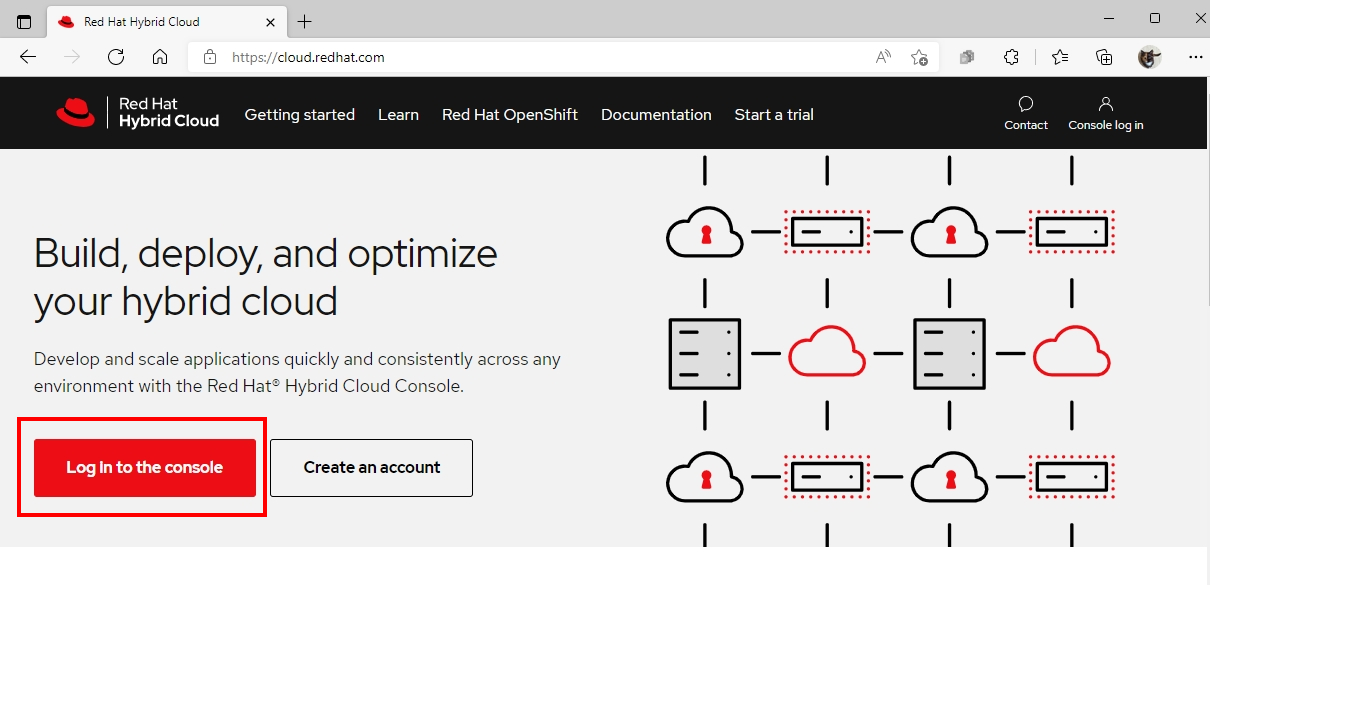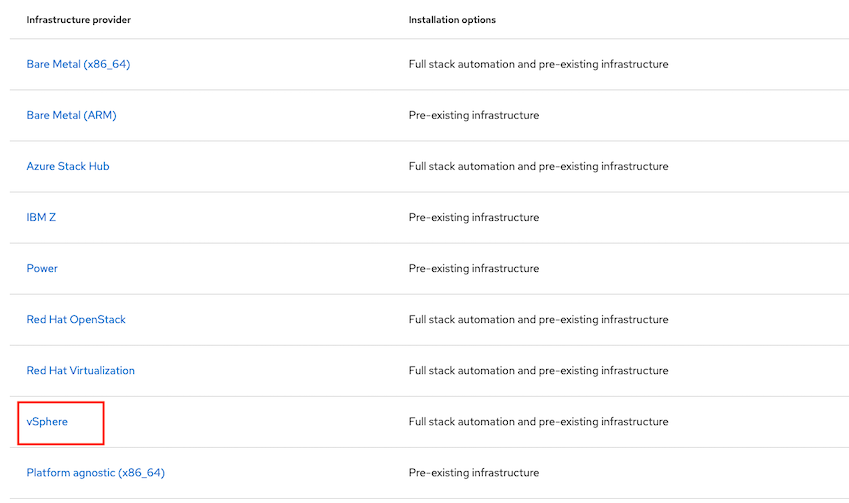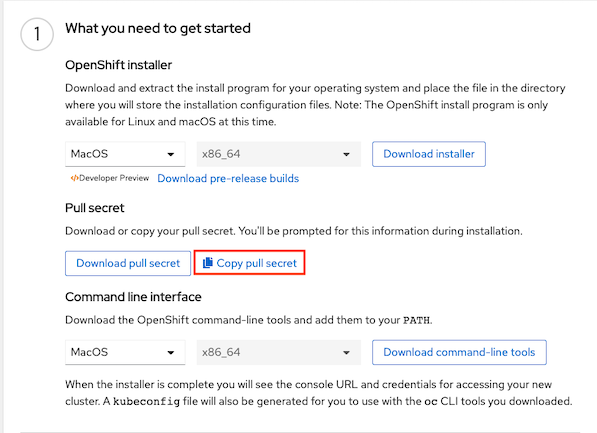Installation on vSphere
Prerequisites
Prepare below before deploy OpenShift Cluster
- Recommended vSphere version
- VM hardware version 15 or later
- vSphere version 6.7U3
- Requires to access to port 443 to vCenter and all ESXi hosts
- Global Administrative privileges account of vCenter
- 856 GB space on Storage
- 2 IP Addresses for API and Ingress
- DNS records for two static IP addresses (API and Ingress IP Address)
- DHCP Server
- vCenter root CA to trust installation host with vCenter before deploy OpenShift
- Pull secret from https://cloud.redhat.com
- Evaluation subscription can be found at try.openshift.com
- Internet Access during installation process
- Generating a Key Pair for cluster node with SSH Access
- Download the OpenShift Command-line tools and Openshift installer
Default CPU , Memory and Disk sizing for Openshift node after finish deployment**
| Node Type | vCPU | Mem(GiB) | Storage (GB) | IOPS |
|---|---|---|---|---|
| Control Plane | 4 | 16 | 100 | 300 |
| Compute | 2 | 8 | 100 | 300 |
Preparation
prepare the bastion node to install OpenShift Container Platform. This includes installing the AWS Command Line Interface , the OpenShift Installer , and the OpenShift CLI
Connect to your administration host
ssh <user name>@bastion.<Domain Name>Switch to
rootusing thesudocommandsudo -iSwitch to root using the sudo command
sudo -iInstall OpenShift CLI Tools
- Download OpenShift Installer and OpenShift Client (oc) from here
Install OpenShift Installer
tar zxvf <OpenShift-Installer> -C /usr/bin chmod +x /usr/bin/openshift-installInstall OpenShift Client (oc)
tar zxvf <OpenShift Client> -C /usr/bin chmod +x /usr/bin/ocOptional: setup bash completion
openshift-install completion bash >/etc/bash_completion.d/openshift-install oc completion bash >/etc/bash_completion.d/openshiftInstall OpenShift
Get pull secret from cloud.redhat.com
Login to cloud.redhat.com

Navigate to OpenShift Menu->Cluster->Select tab Datacenter->vSphere ->Installer-provisioned-infrastructure

Copy pull secret and you can also download CLI from here.

Save your pull secret for use later
Create an SSH keypair to be used for your Openshift environement
ssh-keygen -f ~/.ssh/cluster-{Name}-key -N ''Run OpenShift Installer for interactive installation
openshift-install create cluster --dir <installation_directory>Input your cluster configuration
? SSH Public Key /home/<user_name>/.ssh/cluster-{Name}-key.pub ? Platform vsphere ? vCenter <vCenter's IP address> ? Username <Administrator Privileges account of vCenter> ? Password <Password of Administrator account> INFO Connecting to vCenter <vCenter's IP address> ? Datacenter <Data Center name for deploy OpenShift cluster> ? Default Datastore <Data Store for deploy OpenShift Cluster> ? Network <Network vlan id that same vlan with API and Ingress IP address> ? Virtual IP Address for API <API static IP Address> ? Virtual IP Address for Ingress <Ingress static IP Address> ? Base Domain <FQDN for OpenShift Cluster> ? Cluster Name <your OpenShift Cluster Name> ? Pull Secret [? for help] ***************************************************************************************************************************************************************Output
INFO Creating infrastructure resources... INFO Waiting up to 20m0s for the Kubernetes API at https://api.cluster-e9eb.sandbox1409.opentlc.com:6443... INFO API v1.19.0+e49167a up INFO Waiting up to 30m0s for bootstrapping to complete... INFO Destroying the bootstrap resources... INFO Waiting up to 40m0s for the cluster at https://api.cluster-e9eb.sandbox1409.opentlc.com:6443 to initialize... INFO Waiting up to 10m0s for the openshift-console route to be created... INFO Install complete! INFO To access the cluster as the system:admin user when using 'oc', run 'export KUBECONFIG=/home/wkulhane-redhat.com/cluster-e9eb/auth/kubeconfig' INFO Access the OpenShift web-console here: https://console-openshift-console.apps.cluster-e9eb.sandbox1409.opentlc.com INFO Login to the console with user: kubeadmin, password: ********** INFO Time elapsed: 32m6sset up the OpenShift CLI
export KUBECONFIG=$HOME/cluster-{NAME}/auth/kubeconfig echo "export KUBECONFIG=$HOME/cluster-{NAME}/auth/kubeconfig" >>$HOME/.bashrcValidate your clusters
Check that you are cluster administrator
oc whoamiOutput
system:adminValidate that all nodes have a status of Ready
oc get nodesOutput
NAME STATUS ROLES AGE VERSION vm-testvm-master-0 Ready master 24m v1.19.0+e49167a vm-testvm-worker-4dtqf Ready worker 17m v1.19.0+e49167a vm-testvm-worker-lr8ll Ready worker 19m v1.19.0+e49167a vm-testvm-master-1 Ready master 24m v1.19.0+e49167a vm-testvm-worker-t2j5v Ready worker 19m v1.19.0+e49167a vm-testvm-master-2 Ready master 24m v1.19.0+e49167a